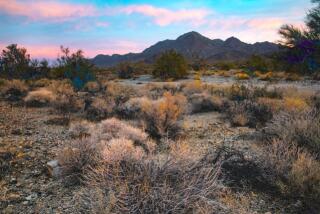Judge Bars Building on Indian Site : Development: The temporary order prohibits Cal State Long Beach from doing an archeological survey on 22 acres considered sacred by the Gabrielino tribe.
- Share via
American Indians won an emotional victory Friday when a Superior Court judge temporarily blocked Cal State Long Beach from building a mini-mall on 22 acres that the Indians consider a sacred site.
Many of the nearly 50 Indians who packed the Los Angeles courtroom hugged and wept after Judge Stephen E. O’Neil’s ruling that the land remain undeveloped until the court determines whether the site is culturally significant.
“I am filled with joy at this decision,” said Jimi Castillo, a spiritual leader of the Gabrielinos, whose ancestors inhabited Southern California centuries ago. “It strikes the proper balance.”
Castillo is among nearly 30 Indians named in a complaint filed last month against the university by the American Civil Liberties Union.
Two weeks ago, the judge temporarily stopped university workers from preparing the land for an archeological survey. Friday’s injunction extends that order and guarantees access to the grounds, including the former two-acre garden that sparked the controversy.
Gardeners were forced to vacate their plots in March so the university could begin the survey. The plots were plowed under and a chain-link fence was erected around the garden, prohibiting access.
Since then, the university has proposed several uses for the land adjacent to Bellflower Boulevard, including faculty housing, a mini-mall or an Indian cultural heritage museum.
But the Indians rejected any development of the land. They said it is the site of an ancient Gabrielino village called Puvungna and the birthplace of the deity Chunquichnish. Many said they have visited the site for years for meditation and spiritual reflection and believe that it should remain untouched and accessible.
In June, the state’s Native American Cultural Heritage Commission recommended that the university abandon its development plans for the site, which is listed on the National Register of Historic Places.
Attorneys for the university contend that there is little proof that the site is culturally significant. They argue that six previous archeological surveys have failed to produce artifacts, bones or other evidence that suggest it was an Indian village.
Officials have offered to conduct a seventh review, focusing primarily on the two-acre garden site.
The site’s cultural significance probably will be the central question when the two sides meet again in court. No date has been set for the hearing. Until then, the fence must remain unlocked, and the university must halt all plans for an archeological survey.
“This is the last bit of land we have that is undeveloped in the whole area,” said Bernard Alvitre, 68, a Gabrielino Indian who said he used to visit the site as a child.
More to Read
Sign up for Essential California
The most important California stories and recommendations in your inbox every morning.
You may occasionally receive promotional content from the Los Angeles Times.










